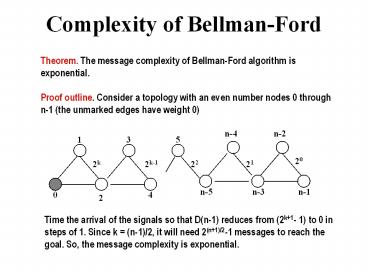Complexity of Bellman-Ford - PowerPoint PPT Presentation
Title:
Complexity of Bellman-Ford
Description:
... (a token or mobile agent or a robot). ... Concurrent Reading and Writing using Mobile Agents Author: Sukumar Ghosh Last modified by: Sukumar Ghosh – PowerPoint PPT presentation
Number of Views:231
Avg rating:3.0/5.0
Title: Complexity of Bellman-Ford
1
Complexity of Bellman-Ford
Theorem. The message complexity of Bellman-Ford
algorithm is exponential. Proof outline.
Consider a topology with an even number nodes 0
through n-1 (the unmarked edges have weight 0)
n-4
n-2
1
3
5
20
2k-1
22
21
2k
n-5
n-3
n-1
0
4
2
Time the arrival of the signals so that D(n-1)
reduces from (2k1- 1) to 0 in steps of 1. Since
k (n-1)/2, it will need 2(n1)/2-1 messages to
reach the goal. So, the message complexity is
exponential.
2
Interval Routing
(Santoro and Khatib)
- Conventional routing tables have a space
complexity O(n). - Can we route using a smaller routing table?
Yes, by using interval routing. This is the
motivation.
condition port number
Destination gt id 0
destination lt id 1
destination id (local delivery)
3
Interval Routing Main idea
- Determine the interval to which the destination
belongs. - For a set of N nodes 0 . . N-1, the interval
p,q) between p and q (p, q lt N) is defined as
follows - if p lt q then p,q) p, p1, p2, .... q-2,
q-1 - if p q then p,q) p, p1, p2, ..., N-1,
N, 0, 1, ..., q-2, q-1
5,1)
3,5)
1,3)
4
Example of Interval Routing
N11
Labeling is the crucial part
5
Labeling algorithm
- Label the root as 0.
- Do a pre-order traversal of the tree. Label
successive nodes as 1, 2, 3 - For each node, label the port towards a child by
the node number of the child. - Then label the port towards the parent by L(i)
T(i) 1 mod N, where - - L(i) is the label of the node i,
- - T(i) of nodes in the subtree under node i
(excluding i), - Question 1. Why does it work?
- Question 2. Does it work for non-tree topologies
too? YES, but the construction is somewhat
tricky.
6
Another example
Interval routing on a ring. The routes are not
optimal. To make it optimal, label the ports of
node i with i1 mod 8 and i4 mod 8.
7
Example of optimal routing
Optimal interval routing scheme on a ring of six
nodes
8
So, what is the problem?
- Works for static topologies. Difficult to adapt
to changes in topologies. - But there is some recent work on compact routing
in dynamic topologies (Amos Korman, ICDCN 2009)
9
Prefix routing
- Easily adapts to changes in topology, and uses
small routing tables, so it is scalable.
Attractive for large networks, like P2P networks.
a
b
When new nodes are added or existing nodes are
deleted, changes are only local.
a.a.a
a.a.b
10
Another example of prefix routing
destination
130102
203310
13010-1
source
1301-10
Pastry P2P network
130-112
13-0200
1-02113
11
Spanning tree construction
For a graph G(V,E), a spanning tree is a
maximally connected subgraph T(V,E), E? E,such
that if one more edge is added, then the subgraph
is no more a tree. Used for broadcasting in a
network with O(N) complexity.
- Chang-Roberts algorithm The root is known
- main idea Uses probes and echoes, and
- keeps track of deficits C and D as in
- Dijkstra-Scholtens termination detection
algorithm - first probe --gt parent sender C1
- forward probe to non-parent neighbors
- update D
- echo --gt decrement D
- probe and sender ? parent --gt send echo
- C1 and D0 --gt send echo to parent C0
Parent pointer
Question What if the root is not designated?
12
Graph traversal
Think about web-crawlers, exploration of social
networks, planning of graph layouts for
visualization or drawing etc.
- Many applications of exploring an unknown graph
by a visitor - (a token or mobile agent or a robot). The goal of
traversal - is to visit every node at least once, and return
to the starting point. - - How efficiently can this be done?
- - What is the guarantee that all nodes will be
visited? - - What is the guarantee that the algorithm will
terminate?
DFS (or BFS) traversal is well known, so we will
not discuss about it
13
Graph traversal
Tarrys algorithm is one of the oldest (1895)
- Rule 1. Send the token towards each neighbor
exactly once. - Rule 2. If rule 1 is not applicable, then send
the token to the parent.
A possible route is 0 1 2 5 3 1 4 6 2 6 4 1 3 5
2 1 0
Nodes and their parent pointers generate a
spanning tree.
14
Minimum Spanning Tree
- Given a weighted graph G (V, E), generate a
spanning tree T (V, E) E? E such that the sum
of the weights of all the edges is minimum. - Applications
- Minimum cost vehicle routing
- On Euclidean plane, approximate solutions to the
traveling salesman problem, - Lease phone lines to connect the different
offices with a minimum cost, - Visualizing multidimensional data (how entities
are related to each other) - We are interested in distributed algorithms only
The traveling salesman problem asks for the
shortest route to visit a collection of cities
and return to the starting point.
15
Example
16
Sequential algorithms for MST
- Review (1) Prims algorithm and (2) Kruskals
algorithm. - Theorem. If the weight of every edge is
distinct, then the MST is unique.































